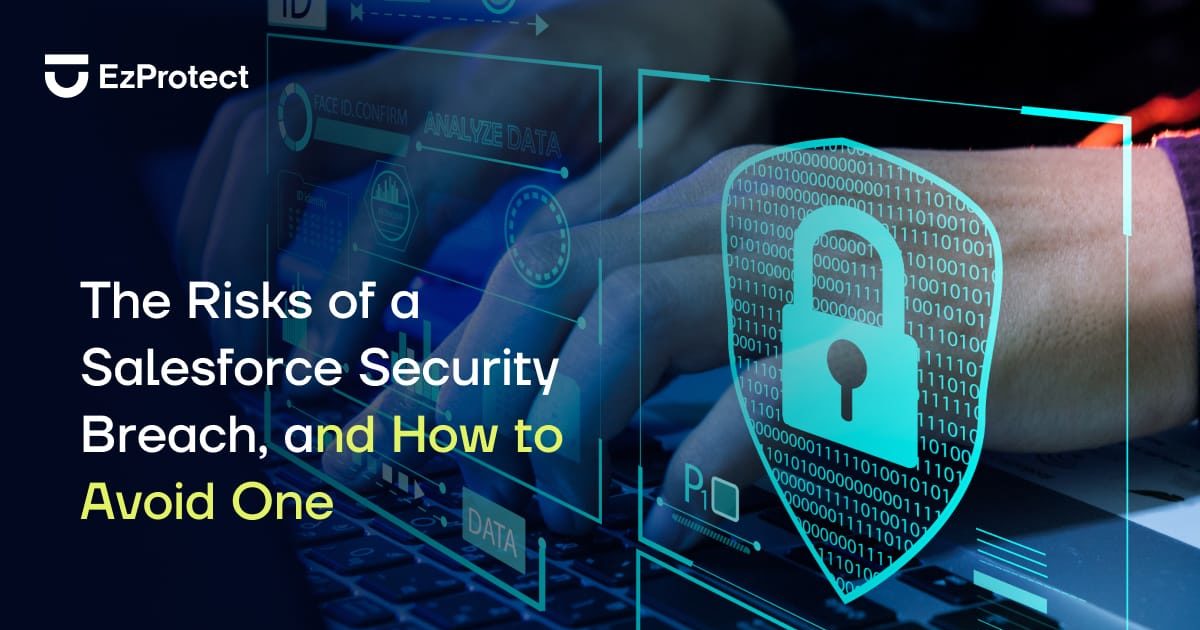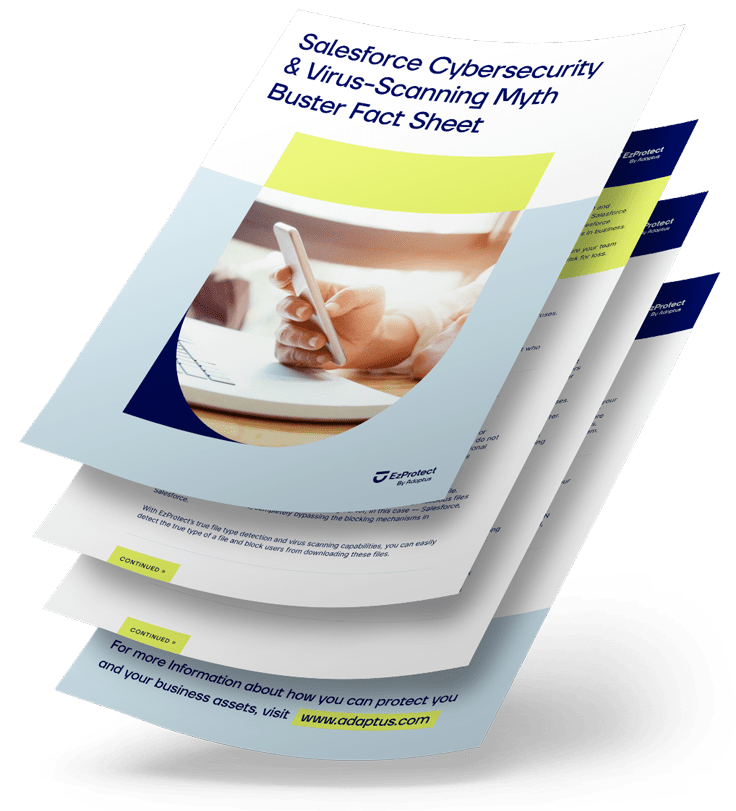Share
Today, many organizations live and breathe Salesforce, and its popularity has skyrocketed more than ever. Higher revenue, better customer satisfaction, and business growth elevate the demand for salesforce more and more. However, with its myriad advantages, the platform also has some serious security concerns that need addressing.
In 2021 alone, over 22 million records were exposed. No doubt, Salesforce comes with various control sets to protect the data stored in Org. But there are still certain errors and vulnerabilities that put sensitive information at risk. Therefore, every organization’s priority should be ensuring Salesforce’s security remains intact. Now you may wonder: what are the risks of a Salesforce security breach? In this blog, you will get to know all the details, but first, let’s understand the Salesforce data security model.
What is the Model of Salesforce Data Security?
Be it personal records or Org data, Salesforce has its own model for safeguarding all that information. There are three layers of security through which the tool looks after your organization’s data.
- Object-Level-Security: Salesforce by default uses a pessimistic approach when it comes to data security. It verifies whether the user has permission to view that particular type of object, and then it allows access. For managing object-level security, it uses permission sets, two types of configurations, and profiles.
- Field-Level-Security: Even if a person can access objects, he or she still has to get access to individual fields. For example, administrators have the power to give read or write permission to a user, and they can also remove all access from that field.
- Record-Level-Security: This type of security deals with record sharing and controls users’ access to records. There are sharing rules, role hierarchy, manual sharing, and organization-wide sharing defaults to decide who can have access to the record.
Even though Salesforce offers a top-notch model to protect the data, there are certain aspects of its environment that threat actors can exploit.
Top Risks Associated with a Salesforce Security Breach

Like any other tool, Salesforce also has some blind spots that can pose a major hazard to your organization. Here are some of the security risks of a Salesforce security breach.
1. Authorization Vulnerabilities:
As Salesforce is a multi-user environment, access control or authorization becomes a big part of the security. When used correctly, each person can access only those functions and resources that are designated to them. Unfortunately, implementing the following authorization schemas will leave your application exposed to threats.
- If a single user gives access to multiple users
- If developers have less understanding of platform operations and access controls.
- When developers lack awareness of input manipulation, hackers use exploit them
2. Connection with APIs:

APIs create interactions between different software and are used to improve the overall experience between disconnected systems. Salesforce uses APIs to enhance the user experience, but unsecure third-party apps expose users to a variety of threats. Some of them include:
- Code Injections: Attackers put a malicious code in between the API codes to extract information from Salesforce Org.
- DDoS Attacks: Here, multiple systems perform a DDoS attack on a single system, causing the system to slow down or shut down.
- Replay Attacks: In this attack, the threat actor makes a user request to get information about authorized credentials.
- Exposed cardholder data: With debugging tools, attackers can get the information of the cardholder, thus leaving it unsecure.
- URI keys having important data: Some APIs also give a URI with an access key, but the details of the URI include passwords, system logs, and many other confidential data.
Integrating with an unsecured API can create compliance problems and result in data breaches.
3. Insider Threats:

When it comes to insider threats, any Salesforce user could be one. However, it depends on the roles and the access levels they have to extract information. Most companies today allow users to access Salesforce on personal devices, which leads to more risks. Certain insider threats to look out for are:
- Ex-employees who know all essential information of the organization.
- Users who commit errors due to negligence put data at risk.
- Insiders who intentionally disclose data to hamper the organization’s reputation.
- Some users who have more rights than they need can create security threats by making configuration modifications.
4. Increased Data Exposure:
In number of ways a user can access the data of Salesforce and it is a necessity now to control those who have the power to get your Org data. With expansion of a company, evolves the data pool and keeping it secure becomes difficult. Providing improper permissions to users leads to overexposure of data, thus making them vulnerable to attacks. If you are someone who doesn’t update third-party applications more often, then that also exposes your data to new threats.
5. Risks of Coding Errors:
New application and update creation on Salesforce does produce numerous opportunities for your organization. However, a single code error may create a huge security risk. During the development process, each security issue should be checked, and the quality of codes also needs proper scrutiny so that no one can exploit the data stored in them.
Ways to Assess Salesforce Data Security Risks
Data security risks in Salesforce are quite unavoidable but knowing where the vulnerabilities may lie is a great way to overcome the danger. Take a look at these points to assess the risks present in your Salesforce environment.

- Find out Who has Access to Information: You may think of cybercriminals whenever the topic of data security comes up. But sometimes, insider threats are the worst ones. Employees often unintentionally expose your data to risk through mistakes like accidental deletion or incorrect access methods. Therefore, control the permission settings and give access to only those who directly require it.
- Categorize the types of data: First, start with separating the different types of data that have chances of exploitation. All information is important but certain data hold more importance that you would never want to be compromised. So, evaluate all data sets and group them on the basis of their sensitivity.
- Identify Potential Vulnerabilities: Hackers often go to the login screens to enter your system. Therefore, use strong passwords and multi-factor authentication to enhance security.
- Monitor Reporting Procedures: Documenting everything to know the potential threats that could create a bigger issue. Track access logs and login history to learn whether it is used by any unauthorized person.
- Consider Backup Options: It is always better to prepare for a data loss, and installing a backup system is the best way to do so. Whether it’s a natural disaster or a system failure, you’ll need a backup to recover your data.
- Prioritize Security Scanner: No matter how many rules you follow to protect your system, there are still some vulnerabilities that can put it in danger. Hence, prioritize using a security scanner like EzProtect that scans for viruses and safeguards your business from huge losses.
Wrapping Up
Salesforce is one of the biggest CRM platforms, but it also poses data security risks. Although it is increasing the security effort, the risks of new vulnerabilities still put your system in danger. The perfect way to mitigate these risks is by opting for a complete cybersecurity solution that prevents damage and saves you millions.
If you are concerned about your data being exposed or unsafe, Book a FREE Salesforce security assessment, to see if you are at risk. Come visit our site today, if you would like to learn more about EzProtect, and how we can help protect you.
Share
Did you love this blog and wish there could be more?
It is our goal to keep you informed about everything you need to know about Salesforce security to keep your Salesforce data and company safe and secure by providing you with the highest quality of original content.
If this sounds good to you, then sign-up below to be one of the first to know when the next super awesome Salesforce security blog has been released.

